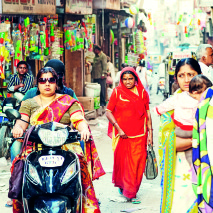India is going to build 100 Smart Cities all over the country. The cities will be more sustainable, offering their residents an enhanced quality of life, making them more prosperous, healthier and happier.
There is not one truly Smart City in the world,” asserts Amitabh Kant, Secretary in the Indian government’s Department of Industrial Policy and Promotion. “There are at best cities which have partial smart connectivity.” In India, the process of urbanisation has only just begun, but this trend is now advancing at a terrific pace. Some 433 million people – almost one third of India’s total population of 1.3 billion – currently live in cities. The United Nations predicts that over 400 million more will be city-dwellers by 2050. “In the past, you (ed: the West) could pollute the world. We cannot allow ourselves that luxury,” Kant concludes.
It all starts with the vision
This is also the context behind the vision of a “Digital India” promulgated by India’s Prime Minister Narendra Modi. It includes a plan to build 100 Smart Cities all over India. “Cities in the past were built on riverbanks. They are now built along highways. But in the future, they will be built based on availability of optical fibre networks and next-generation infrastructure.” So, in April 2015, the Indian government launched its “100 Smart Cities” programme. Initially at some 100 locations around India, Smart Cities will either be built entirely new on greenfield sites, or existing cities will be made more efficient and their quality of life enhanced.
In a country such as India, especially, the first pressing need is to establish the fundamentals for such development, including stable water supply and sewage systems, provision of electricity to all areas and public transport. Only once all of those infrastructure systems are in place will aspects of digital connectivity and information technology come into play, enabling the city to become smart. The official aim of the programme is to create efficient infrastructure in all respects, so as to make the cities more sustainable, and offering their residents an enhanced quality of life, making them more prosperous, healthier, and happier. To financial the initiatives, the Indian government is relying on Public Private Partnerships. An Indian commission of experts has estimated that capital investment of some 4.6 billion euros per year will be necessary for water supply, sewage systems and transport infrastructure alone. The total required investment is likely to be well above that. That’s why India has also invited foreign partners to help the country develop the Smart Cities. Contracts to this effect have already been signed for eight cities: three with Germany, three with the USA and one each with Spain and Singapore.

Implementation is in progress
98 potential Smart Cities were designated in August 2015. In January 2016, 20 cities were selected as the first to receive funding. Kochi is one of the cities which has set itself the aim of enhancing its residents’ quality of life through investment in public infrastructure and modern services. As one example, an integrated water-based transport system is being built with the aid of a loan from Germany’s KfW development bank. The plan is to create a municipal transport system combining waterways, buses, a metro system and transport methods such as auto rickshaws and bicycle hire. To ensure smooth running of the future transport system, the routes, timetables and ticketing will be coordinated and integrated. Seamless transportation will be aided by electric buses and rickshaws serving as shuttles to the ferries, as well as by the development of pedestrian footpaths and cycle routes. The ferries procured as part of the project will consume 20 per cent less fuel than the boats currently in use.
In Visakhapatnam, the focus is initially on launching an eGovernment system and a command and control centre. The control centre will converge various aspects of municipal administration, as well as incorporating services such as the city finance department and the police. “Surveillance of the beaches will also be part of the control centre’s remit,” states city council member Pravin Kumar. He regards the project as a milestone in the municipal administration of Visakhapatnam, commenting: “We are now in a position to implement the plans for the Smart City.” That also includes a reliable round-the-clock water supply, solar panels on the roofs of public buildings and solar modules for street lights.
Opportunities for companies from all over the world
The “100 Smart Cities” project also represents a major opportunity for industrial companies from all over the world. The key demand is to establish technology centres and create jobs in India itself. Sangeeta Prasad, CEO of the Mahindra World City organisation: “Without jobs, an interconnected system lacks the most important thing: a soul.”
(picture credits: Istockphoto: powerofforever, sabirmallick, Nikada; Photocases: spirelli)



